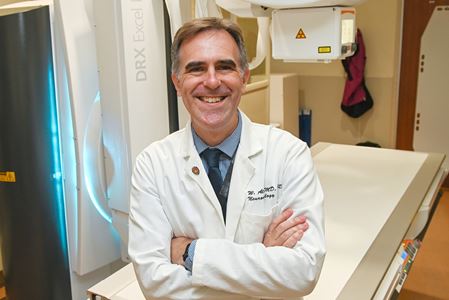INDIANAPOLIS—Indiana University School of Medicine has named a transformative leader as the new chair of the Department of Radiology and Imaging Sciences.
Jason W. Allen, MD, PhD, FACR will assume the role of department chair effective October 1 and will have oversight and responsibility for the program’s clinical, educational and research programs.
A highly-respected physician-scientist in the field of radiology, Allen is currently the Director of the Division of Neuroradiology and Director of the Laboratory for Imaging Neurosciences at Emory University School of Medicine in Atlanta, Georgia, where he is an Associate Professor of Radiology and Imaging Sciences and Neurology. He is also a Program Faculty in the Wallace H. Coulter Department of Biomedical Engineering at Emory University School of Medicine and Georgia Institute of Technology.
“Dr. Allen’s diverse training and career experience have uniquely prepared him to lead and transform our Department of Radiology and Imaging Sciences,” said Jay L. Hess, MD, PhD, MHSA, dean of IU School of Medicine and Executive Vice President of University Clinical Affairs for IU. “His vision aligns with the Department of Radiology’s interdisciplinary approach to clinical research and patient-centered care and will advance the department to the next level of excellence.”
Allen began his career at TRA Medical Imaging, a large radiology-led private practice in Tacoma, Washington, where he held many leadership roles. During this time, he also served as the Medical Director of Radiology and Vice President of Medical Staff at St. Anthony Hospital in Gig Harbor, Washington, where he helped design and implement the first entirely digital radiology department in the Franciscan Hospital System.
Driven by a passion for academic medicine, Allen joined the faculty at Emory University School of Medicine in 2013 as an Assistant Professor of Radiology and Imaging sciences. As the Director of the Division of Neuroradiology, he oversees the clinical and research programs across 11 Emory University hospitals as well as Grady Memorial Hospital, the largest Level I Trauma Center in Georgia. Under his leadership, the division significantly expanded its faculty to become one of the largest neuroradiology divisions in the country.
Allen’s research lab is funded by a number of NIH, foundation, and institutional grants and uses advanced MR imaging to study traumatic brain injury and cerebrovascular diseases. In his research, Dr. Allen has demonstrated some of the first evidence that post-concussive vestibular impairment may be driven by maladaptive increased weighting of visual sensory input into the vestibular network. His work has also significantly contributed to our understanding of internal carotid artery webs, a frequent cause of ‘cryptogenic’ strokes in younger patients. Over his research career to date, Allen has published more than 100 manuscripts and book chapters.
“I am honored by the opportunity to lead the Department of Radiology and Imaging Sciences,” said Allen. “Having spent time as a basic and clinical researcher, a neurologist, and a radiologist, I am acutely aware of the needs and wants of each of these groups. I’m looking forward to the challenge of helping this complex and dynamic department continue to grow and become a leader in radiology clinical care and research innovation.”
In 1993, Dr. Allen graduated from Tulane University with a bachelor’s degree in cellular and molecular biology. He earned his MD and a PhD in neuroscience from Georgetown University in 2000. He completed an internship in medicine at New York University in 2001, followed by residencies in neurology and diagnostic radiology at NYU in 2003 and 2005, respectively. He also completed a clinical fellowship in neuroradiology at NYU in 2007.
###
IU School of Medicine is the largest medical school in the U.S. and is annually ranked among the top medical schools in the nation by U.S. News & World Report. The school offers high-quality medical education, access to leading medical research and rich campus life in nine Indiana cities, including rural and urban locations consistently recognized for livability.




